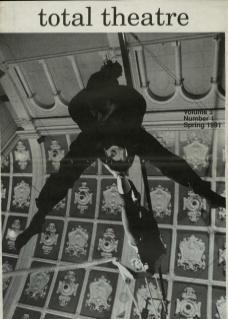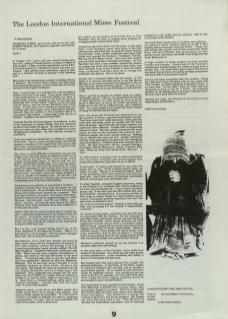In October 1977 I got a call from Joseph Seelig (who was he?), asking if I would perform a couple of nights at The Cockpit – a little out-of-the-way theatre run by ILEA. If I'd never heard of it, I doubted if anyone else had, so I refused. I did, without much enthusiasm, agree to take part in a ‘Festival’ of mime in January of the following year.
Mime was in its hard-working, ecstatic, frustrating infancy in England. The Festival wasn't brilliant, but there were some good performances, of which Nola Rae is the sole survivor of the English contingent.
Now, fourteen years later, it is probably the most prestigious festival of its kind in the world. It has grown slowly from a few performances in a 100 seat theatre to a bevy of much larger venues, ranging in size from the 40 seat Battersea Arts Centre Studio Theatre, to the 400 seat Purcell Room, and the Queen Elizabeth Hall (1000 seats). It must now rank in theatrical excitement and expertise with other larger, more conventional festivals. Kenneth Rae (no relation) in The Guardian calls it ‘a provocative little festival... a pilgrimage to the source of theatre’. I quibble only with the word ‘little’.
Festivals like this don't just happen – its existence is due to the inspiration of Joseph Seelig, who has continued to direct it and widen its appeal. He had the wit to see a future for mime at a time when only a handful of us were struggling for recognition. He also had the courage to promote it. There are enormous headaches in putting on a festival of this kind. There is never enough money, and though Joseph is uncritical of the support the Arts Council and GLA give, commercial sponsorship is hard to find. Money is a constant frustration.
Also there is great difficulty in breaking new ground – Joseph says that new shows of sufficient quality to put in the Festival are hard to find. Interestingly, where Joseph Seelig might argue, ‘it may be new, but is it good?’, David Glass would reply, ‘if it's new it is good’. The quest for the new has not prevented the same storyline appearing in the Festival three times in the last three years. Cotillard's Les Hommes in this year's Festival was, yet again, about the rivalry between a group of people in a waiting room. An old idea, but brilliantly executed and athletically immaculate. Undoubtedly one of the hits of this Festival.
Advertising and publicity is everybody's problem. I quoted to Joseph Time Out's tired old opener for this year's Festival puff: ‘If you thought mime was all white gloves and painted faces, prepare for a surprise.’ This was how London's foremost, self-styled alternative, dynamic, finger-on-the-pulse magazine began its article this year – and last year – and the year before – and... yawn... zzzzzzz. At least we were spared the ‘Mime Finds its Voice’ kind of publicity we've been subjected to for the past few years.
Neither Time Out nor almost anyone else in London has seen a white-face performance in the theatre in the last ten years. It is passé, and we've moved on. As a profession we have moved so far from that kind of image and style it would be verging on the avant-garde to present white-face now.
But it is this, says Joseph Seelig, that is one of the major obstacles in mounting the Festival. ‘Mime is a bad word for a lot of people. That has never changed. Never will. We're using the wrong word.’
Nevertheless, it is a word that Joseph has stuck by when many others felt too threatened and dropped it. This view, however, mirrors the findings of an Arts Council-commissioned report grandly entitled ‘The UK Mime Audience - Qualitative Research’, produced in late 1989. ‘Mime has too many negative connotations’, it states, referring to ‘the age-old barrier of the word Mime’. ‘Companies that cease to use the word Mime are to be applauded!’ Whacko for McCann, Matthews, Millman! Just as well they weren't brought in to do qualitative research on Jesus Christ. He was a real non-starter. But change his name to Confucius and call his religion Buddhism and he'd really bag a few followers! They suggested that Joseph lose the word Mime from the Festival, but couldn't think of anything to replace it, so faut de mieux, might as well leave it as it is. Now there's a forward-looking, really useful and dynamic conclusion. I wonder how much the report cost? It is full of like wonders.
Joseph is aware, as we all are, that Mime sparks off a certain image that a lot of people react against. And many of those people are journalists. ‘It is very hard to convince journalists to abandon the need to categorise a performance,’ he says, ‘and to many journalists and most of the public, mime is white-face.’
He makes an exception of Kenneth Rae in The Guardian, who, he says, is making some progress in changing people's ideas about mime.
Joseph has got more canny over the years. In the early days, if any reviewers came, they came to the first performance, and if that was no good the whole Festival was damned. Later, certain companies were given high profile and opened the Festival – Footsbarn, Polivka, Moving Picture Mime Show. But even this cannot prevent blind prejudice amongst journalists. In The Spectator last year a lady reviewer opened her column by saying how much she had always hated mime, had been reluctant to go to the Festival to have her worst fears confirmed, and then went on to ravage the production she did see. She is not alone.
Joseph has a constant battle with our image. In the States it is common amongst mimes to say that Marcel Marceau is the worst thing that has happened to the art (and Decroux would probably agree). He gave it an image that the rest of us are still trying to crawl out from under.
When I put this to Joseph he replied, quick as a flash, ‘absolutely untrue!’. Like me, he agrees that it is the job of other performers in other areas of mime to be as good as Marceau; to touch the public sensitivity as subtly as he can, but in a different way, with a different style. Too many people try to knock him down instead of trying to build themselves higher.
Over the years the Festival has attempted to run discussions, a Forum, question-and-answer panels. They have never been really successful. Every year the same tired old points came up, usually from the same tired old people. Apart from the die-hards, however, the audiences were different. People with a burgeoning interest in mime. But they always expressed the same points of view as the audience the previous year. Different people, but same overall make-up. Nothing new or vibrant ever came out of it. Joseph maintained that the mime profession just spent the time whingeing about its problems. Problems that were someone else's fault – the Arts Council's, GLA's, Joseph Seelig's, journalists', Marcel Marceau's. Never, it seems, their own. Stand up, those who would shout, ‘Not me!’ – I can't.
So, with problems of funding, lack of original perspective from the press, antipathy and preconception from prospective audiences, why does he go on with it?
A fast buck? A rueful smile blasted its way down the phone into my ear. ‘If the Festival doesn't work, we suffer,’ he says. ‘Money is a constant problem. Many of the performers that come demand, and deserve, large fees. And if they come, it's because I persuaded them to, not because I can afford their fees.’
To other hopefuls, emergent English performers, being in the Festival is an accolade that confers legitimacy, success and everlasting life. I have heard countless groups say, ‘If we don't get into the Festival this year, we'll disband.’ And they have. It is hard to rid them of their image of Joseph Seelig as a cigar-smoking, camel-coated, champagne-quaffing impresario who can't tell talent from an elephant's bum. So, is he in it for the power? ‘Seeing a show that you hate, and not putting it in the Festival, is responsibility, not power.’
Of course he has power, and there are spin-offs from his association with the Festival. He has managed or promoted certain performers, and he now runs the Hong Kong Arts Festival, which would certainly not have happened if he had not run such a successful London Mime Festival. Joseph will not compromise his personal integrity and feeling of artistic responsibility. However dull that sounds, I have known him refuse shows, even major productions, that he did not believe in, knowing that it would probably earn him the disapprobation of the Arts Council and people more powerful than himself.
Whatever motivates Joseph to run the Festival, it is altruistic rather than self-serving.
In the early days of the Festival, mime audiences tended to be groupies. You would see the same people at every performance. It was comforting and clubby, a place to meet friends and talk mime.
But Joseph says that once beyond The Cockpit, the potential audiences – at The Place, at The Shaw – began to expand to between 200 and 500, and so needed a much wider appeal. He is careful to pick particular shows for particular venues. You cannot put just any show in the ICA for example, but if the right show goes there maybe the ICA's regular audience would be encouraged to see it and get hooked.
The South Bank is very important to the Festival. It was Dick Matchett, erstwhile Arts Council officer, who encouraged Joseph to go there. And it is at this point that Joseph talks about his great debt to his colleague, Helen Lannaghan. She joined him to design the Festival programmes and be his assistant. But Joseph put more and more trust in her. She did much to develop the South Bank association, and he had total confidence in her ability and her opinions. She is now co-director of the Festival.
The South Bank would reach an entirely new audience – an audience which Joseph refers to as Mr & Mrs Slightly-Above-Average-Cultured-Public. These are also people who spend a lot of time around the South Bank, pick up brochures as they wander round, and hence are liable to try things that the South Bank puts on.
A large number of these people are from outside London and are tourists. Since most of the Festival's advertising is London-based, the audience tends to be a London one. The South Bank goes beyond that and so the shows that go there are usually prestige productions and those with a more general appeal.
And he has been successful with this venture. Filling the 1000 seat Queen Elizabeth Hall for two nights with TAG Theatre, an Italian-speaking Commedia troupe, is no mean feat. On the night I went, Sir Peter Hall was queueing in front of me for a ticket. He probably qualifies as Mr Slightly-Above-Average-Cultured-Public. He even came back after the interval.
Against the odds, the Festival is reaching out and expanding in all directions.

